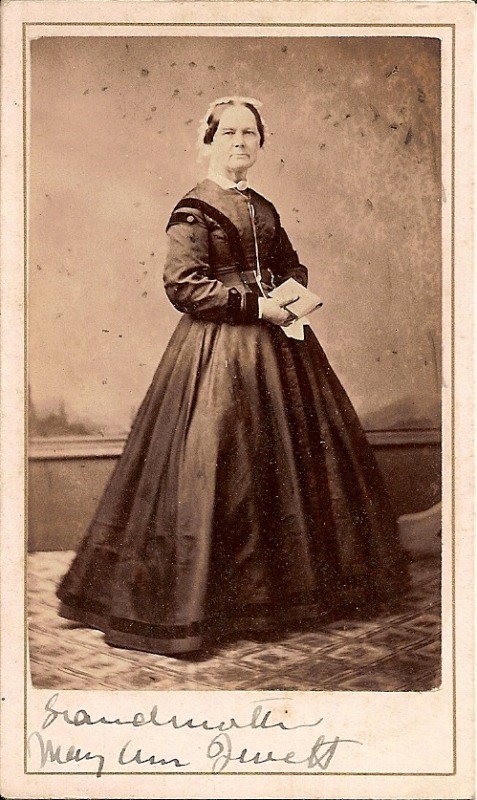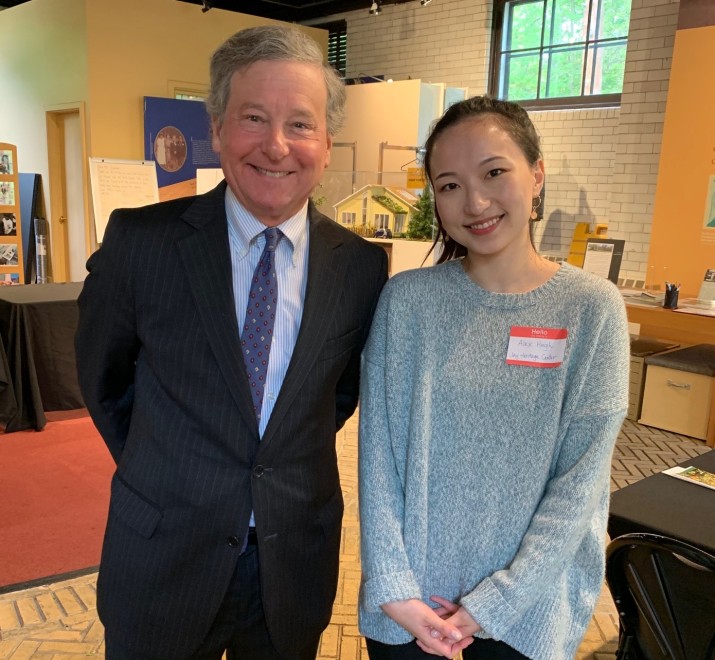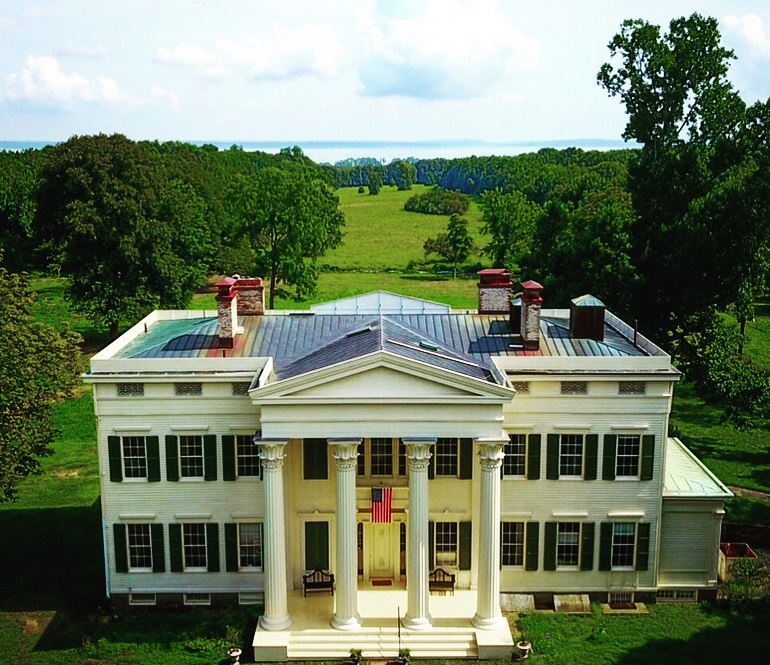
By Alex Hugh
To the Jay Family and many others, Westchester was a haven of cleaner and safer living standards, a comfortable distance from overcrowded New York City yet close enough to the bustling city for individuals to maintain business or familial connections. However, despite Westchester’s reputation as an “unusually healthful” region, its citizens were not always shielded from the diseases and ailments that characterized the 18th and 19th centuries.
Mary Ann Jewett was a member of one such family with its roots in Nantucket, Massachusetts. How and why her family came to Rye is still being researched, but she kept a diary from 1852 to 1856 that gives us some insight into her life. Today the pages are yellowed and worn with over 150 years of age. The entries are written in elegant, looping script, sometimes blue, sometimes black. Mary Ann wrote almost every night in the Rye home she shared with her mother. She recorded the events of each day – the people she met, places she went, and clothing she had sewn. She also wrote about instances when she or anyone in her community fell ill, which will be the focus of upcoming segments of this blog.
Mary Ann was a healthy woman who lived to the age of 79 in 1882, but in her diary, she nonetheless wrote of headaches, fevers, chills, and toothaches. In a future installment we will explore Mary Ann’s experience with summer fevers and how it paints a more nuanced picture of Westchester’s public health in the 1850s. However, this piece will focus on the history of neuralgia and headaches in Mary Ann’s family. There is evidence to suggest that Mary Ann’s mother suffered from migraines, a hereditary type of recurring headache that causes moderate to severe pain. Although Mary Ann’s mother was never formally diagnosed with migraines, nor did the word “migraine” ever appear in her diary, we can use modern day medical knowledge to better contextualize and understand her experiences.
To this day, no diagnostic test exists to confirm headache disorders like migraines. Doctors must use anecdotal evidence and medical history to effectively diagnose and treat recurrent headaches. The U.S. Department of Health and medical practitioners alike recommend that sufferers of headaches keep “headache diaries” in which patients write down each time they experience a headache, their symptoms, and possible triggers.[1] The practice of daily record-keeping of even the seemingly mundane details can serve as an indispensable tool for doctors to identify patterns, categorize headaches, and effectively treat pain. By recording each time she or her mother had a headache, Mary Ann unintentionally created a snapshot headache diary that can be used to better understand the context of her experience.

Mary’s mother, Mary Ann Hayden Russell
Mary Ann’s mother, 68 years old in 1852, suffered from debilitating headaches once or twice a month. Mary Ann never wrote of a specific diagnosis, but if her mother were to see a doctor today, she would likely be diagnosed with migraines. Mary’s headaches in comparison were much less severe, adding up to one or two per year, though some people can experience migraines rarely and still be diagnosed with them.
According to the Migraine Research Foundation, migraines are a type of recurring headache characterized by moderate to severe pain, usually described as throbbing or pulsing. Women are three times more likely to get migraines than men, possibly due to estrogen’s role in pain management. [2] Therefore, some women report their migraines improving after menopause, though for some, menopause worsens migraines or triggers them to start. At 68 years old in 1852, Mary Ann’s mother would have fallen into the latter category.
Mary Ann’s mother’s headaches lasted from several hours to several days. According to the Migraine Research Foundation, the average migraine lasts 4 to 72 hours, and most sufferers experience attacks once or twice a month.[3] Migraines themselves are usually recognized by their debilitating nature. An estimated 90% of migraine sufferers are unable to work or function normally during their migraine. Mary Ann wrote of her mother being “sick all day with headache,” severe enough that she would remain bedridden until the headache passed. Although the two women employed several servants around the house, when her mother had a headache, it came down to Mary Ann to shop for groceries, retrieve mail from the Post Office, and make social calls with friends of her mother and herself.
Accompanying symptoms of migraines include nausea, weakness, sensitivity to light and sound, and changes in vision. [4] Therefore, migraine sufferers usually end up confined to a dark room to rest until their migraine passes. Mary Ann wrote on January 4th, “Mother’s headache still continues.” The next day, “Mother is better, but has not left her room.” Sensitivity to light, weakness, and nausea likely would have been enough to keep Mary Ann’s mother bedridden and unable to leave her home.
Migraines can be brought on by a slew of environmental changes, including changes in weather, certain foods, too much or too little sleep, stress, and even sensory input like bright lights or loud noises. Several of Mary Ann’s mother’s headaches began following a recent change in weather, usually the onset of rain or snow. On January 13, 1853, the day after the first snowstorm of the season, Mary Ann’s mother fell ill with a headache that lasted three days, followed by a day of exhaustion. On April 22nd, Mary Ann wrote, “Rained all day.” On the 24th, she wrote, “A cold stormy day… Mother has been sick two days with headache.” The U.S. National Library of Medicine states that sudden changes weather or barometric pressure can trigger a migraine. [5] If Mary Ann’s mother were to be diagnosed with migraines, her doctor may recognize that the onset of rain or snow was a likely trigger for her migraines.
Mary Ann did not write of consulting a doctor for her mother’s headaches. Even if she had, there was likely little a doctor could do to alleviate her pain. Ibuprofen wouldn’t be invented until the 1950s, and although individuals in the medical and scientific community had begun writing on the mechanisms of headaches in the preceding century, there was little development in the realm of pain treatment. “At any rate, the only reliable analgesics available until the last quarter of the 19th century were opium and its derivatives. Powerful and effective, they also had serious side effects… physicians were very reluctant to use them in the moderate pain associated with most headaches.”[6] Synthetic analgesics, the first reliable drugs that could target the pain of headaches and migraines, wouldn’t be discovered until the 1880s, almost 30 years after Mary Ann’s mother passed away.
In the 19th century, the medical community was more concerned with uncovering explanations for ailments than delivering therapeutic effectiveness. As Jan R. McTavish wrote in 1999, “The nonspecific nature of disease in medical thought before the last quarter of the 19th century essentially dictated the nonspecific nature of therapeutics.”[7] Until scientific methodology based on reproducible experimentation came to be the standard for developing medical treatments, there was little doctors could do to alleviate everyday pain, even if it was debilitating. When her mother was ill, Mary Ann would often write of running errands in her stead, traveling to Port Chester and New York City “for Mother.” At the time, it was perhaps the most she could do.
Medical Understanding in the 1850s
Since the time of Hippocrates, doctors and the general public believed in the humoral system, according to which human bodies were composed of a constant equilibrium of four humors: blood, phlegm, bile (choler), and black bile (melancholy). When a person became ill, their humors were thought to be unbalanced. By the mid-19th century, new concepts of physiology and pathology had begun to emerge, widening doctors’ understanding of the human body and its parts. Through autopsies of the recently deceased, doctors were able to observe firsthand the interconnected nerves, blood vessels, and organs of the human body. However, it would take several decades for the medical community as a whole to cast off the humoral system in favor of cellular pathology, first proposed by Rudolf Virchow in 1855.[8]
Mary Ann’s diary hinted to the emergence of new biological understanding and its presence in the public consciousness. Mary Ann wrote on Christmas Day, 1853, “I have been quite ill the last weeks with Neuralgia. My face gathered and was lanced inside, it makes me feel very weak.” This was Mary Ann’s first entry in three weeks, likely due to the severity of her illness. In the 1850s, rather than to signify a specific disorder, the term ‘neuralgia’ was described all forms of nerve pain, including those associated with toothaches, headaches, and even rheumatism. Migraines themselves were “thereby regarded as a neuralgia of trigeminal nerve branches.” [9] In his 1850 essay on neuralgia, Dr. C. Toogood Downing stated, “It would be wrong to suppose that neuralgia is a new disease. The name only is novel.” [10] This reflected the rising instinct in the medical community to re-conceptualize illnesses as it uncovered the structures and functions of the human body. Dr. Downing defined neuralgia as “the term now generally understood to apply to all those painful disorders, which are apparently unconnected with inflammation or recognisable lesion of a part… a disorder or pain of a well-known nerve.” [11] Dr. Downing’s understanding of neuralgia was based on his understanding of the nervous system. Knowing that nerves were responsible for conducting sensation throughout the body and that his patients reported pain without any other observable cause, he concluded that the pain of neuralgia must be due to the dysfunction or activation of the nerves themselves.
Mary Ann’s statement that her face had “gathered” and was “lanced inside” implies that she was actually suffering from a dental abscess, a pocket of pus that occurs when bacteria invade the dental pulp, the innermost part of the tooth that contains blood vessels and nerves. In the 1850s, people did not yet know of bacteria and their ability to cause immune responses such as fever, inflammation, and pain. Fortunately, the treatment that Mary Ann received differed little from what modern doctors would do to treat an abscess. A doctor used a sharp instrument called a lancet to pierce the swollen area in Mary Ann’s mouth and drain the infection. Lancing was a common treatment for many ailments in the 1800s, and while rarely sterile, it was effective in the case of abscesses if further infection did not occur. After this entry, Mary Ann returned to her normal activities and did not write of another instance of neuralgia.
Mary Ann’s use of the word “neuralgia” to describe her own condition shows that it was not just trained doctors who could access and use emerging medical knowledge. It was also medically accurate to refer to her pain as neuralgia, as pain caused by a dental abscess would have fallen under the category of nerve pain. Where she first heard the term is unclear, though it was likely used by the doctor who performed the lancing on the inside of her mouth. Less than a year later on August 14, 1854, Mary Ann wrote of her son Marshall: “Marshall came home this eve, has Neuralgia in his face.” In other words, Mary Ann’s son experienced symptoms – likely facial pain – similar enough to her own to attribute them to the same diagnosis she received, neuralgia. Mary Ann did not write of Marshall’s face gathering nor of him seeing a doctor for lancing, though she did write that he came down with chills and fever less than two weeks later. In the context of her time, Mary Ann was using the term neuralgia correctly; her son had unexplained nerve pain in his face, similar to her own experience. Although a doctor did not formally diagnose him, Mary Ann rationally concluded that her son’s experience of similar symptoms to her own could most likely be attributed to the same condition.
Mary Ann’s diary gives us a glimpse into her family’s history of facial pain and headaches. Experts today believe that the hereditary nature of disorders that cause these symptoms (migraines, trigeminal neuralgia, cluster headaches) could be due to the passing on of genes related to blood vessels surrounding facial nerves, or even genes that code for certain chemicals in the brain, insufficient levels of which can trigger headaches. It is unlikely to be sheer coincidence that Mary Ann, her mother, and her son all experienced symptoms of pain in the head. As Dr. Siddhartha Mukherjee wrote in his book The Emperor of All Maladies: A Biography of Cancer, “To relieve an illness, one must begin, then, by unburdening its story.” In the face of suffering, Mary Ann did her best to take care of herself and her loved ones. She and her family had to endure the physical pain of headaches and neuralgia because they were decades away from the development of pain-killing drugs. However, by writing of her family’s ailments in her diary, Mary Ann immortalized their perseverance and provided for the future an irreplaceable snapshot of what it was like to live in Rye in the 1850s.
____________________________________________________________________________________
 Alex Hugh is a resident of Rye and graduated from Rye Country Day School in 2012. She is pictured here with NY State Assemblyman Steve Otis.
Alex Hugh is a resident of Rye and graduated from Rye Country Day School in 2012. She is pictured here with NY State Assemblyman Steve Otis.
Alex recently graduated from Barnard College, where she received a B.A. in English with
a Creative Writing Concentration. She specializes in short and long fiction. Alex dreams
of one day becoming a published author, and she is an avid reader with a wide variety of
interests, including biology, history, and art. She currently works as an intern at the Jay
Heritage Center.
[1] “Migraine.” Office on Women’s Health in the U.S. Department of Health and Human Services. Retrieved from https://www.womenshealth.gov/a-z-topics/migraine
[2] [3] [4]“Migraine Facts.” Migraine Research Foundation. Retrieved from https://migraineresearchfoundation.org/about-migraine/migraine-facts/
[5] “Migraine.” MedlinePlus. National Institute of Neurological Disorders and Stroke, U.S. National Library of Medicine. 8 April 2019. Retrieved from https://medlineplus.gov/migraine.html
[6] [7] McTavish, Jan R. “The Headache in American Medical Practice in the 19th Century: A Historical Overview.” Headache, April 1999. Retrieved from https://onlinelibrary.wiley.com/doi/epdf/10.1046/j.1526-4610.1999.3904287.x
[8] Schultz, Myron. “Rudolf Virchow.” Emerging Infectious Diseases vol. 14,9 (2008): 1480–1481. Retrieved from https://www.ncbi.nlm.nih.gov/pmc/articles/PMC2603088/
[9] Pearce, J.M.S. “A headache history.” Brain, Volume 135, Issue 8, August 2012, Pages 2569–2572. Retrieved from https://doi.org/10.1093/brain/aws121
[10] [11] Downing, C. Toogood. Neuralgia: Its Various Forms, Pathology, and Treatment. London: John Churchill, 1851. Retrieved from https://wellcomecollection.org/works/ha6cdus8
[12] Mukherjee, Siddhartha. The Emperor of All Maladies: A Biography of Cancer. New York: Scribner, 2010, 46. Print.


Reblogged this on alex hugh and commented:
i wrote this article on medical history in my hometown!
LikeLike